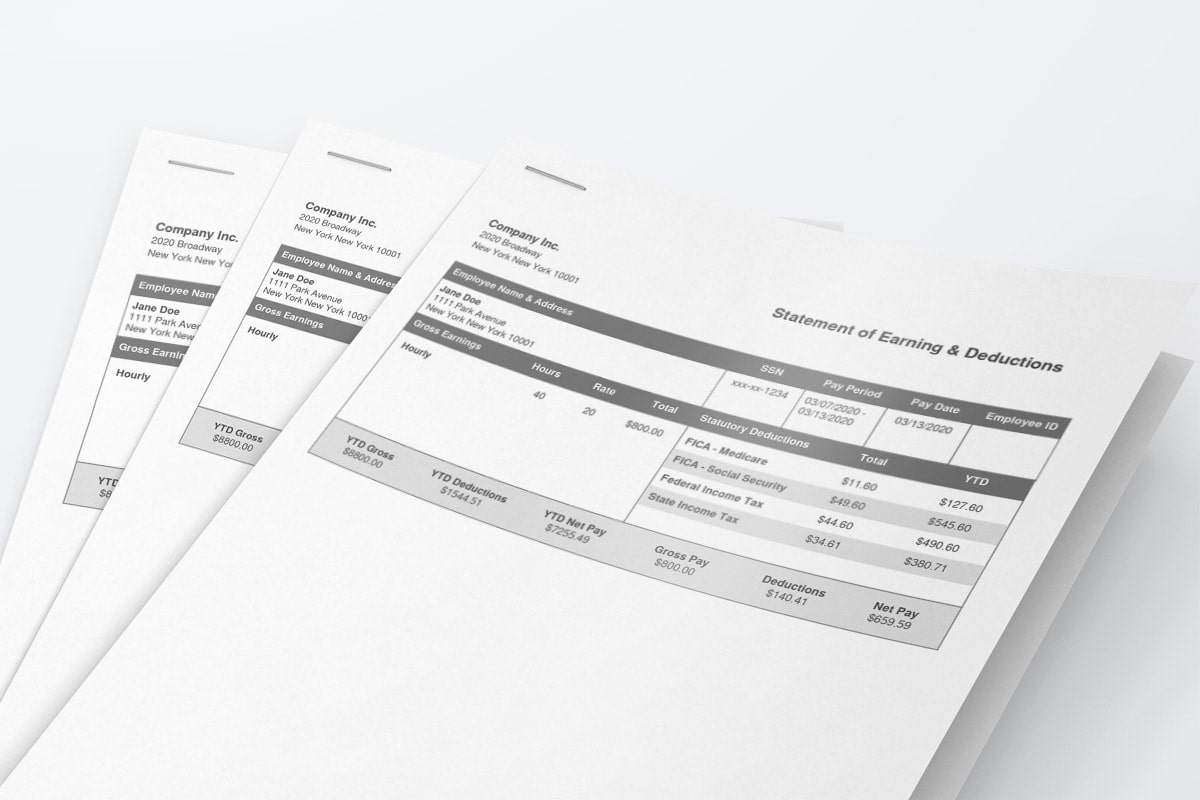What Are Pay Stub Deduction Codes?

Managing payroll effectively requires careful planning and accurate information. A crucial part of this process is creating pay stubs, which detail essential information about an employee’s earnings, deductions, and net pay. Understanding pay stub codes can help both employers and employees interpret these details correctly.
Both employers and employees must understand pay stubs. Employers are responsible for generating precise pay stubs that accurately reflect gross wages, tax withholdings, and other payroll deduction codes. Meanwhile, employees should review their pay stubs to ensure they have been compensated correctly and to verify that their paycheck stub abbreviations align with their earnings and deductions.
This article outlines the key details needed to create a pay stub and explains common deduction codes to help both employers and workers navigate payroll with confidence.
Information Needed to Create a Pay Stub
Determine this information for each employee:
- Payroll cycle: The number of pay periods determines how much salary is paid on each payroll date. It also determines the start and ending days for computing hourly payroll.
- Wages: Gross pay and net pay. Wages may be based on a salary, or calculated using an hourly rate of pay.
- Tax withholdings: Federal, state, and possibly local amounts withheld for taxes.
- Benefit withholdings: Amounts withheld for the employee’s share of insurance premiums, or funds to be invested in a retirement plan.
The rules regarding pay stubs vary by state. Some states require employers to provide pay stubs to workers, while other states do not. Businesses should confirm the requirements in each state where they employ workers.
Employees should keep their most recent pay stubs as proof of income. If an individual applies for a loan, the pay stub confirms the borrower’s gross income. The pay stub information should match the data on each employee’s year-end W-2 form, which individuals used to file their personal tax returns. Reviewing federal pay stub codes ensures accuracy in reported earnings and deductions.
Understanding FICA, FUTA and SUTA Taxes

A pay stub must report Federal Insurance Contributions Act (FICA), Federal Unemployment Tax Act (FUTA), and State Unemployment Tax Act (SUTA) tax information. Employers should use standardized payroll abbreviation codes to label these deductions clearly.
-FICA Taxes-
FICA taxes fund Social Security and Medicare programs. As of 2025, the Social Security tax rate is 6.2% for both employees and employers, applied to earnings up to $176,100. This means the maximum Social Security tax contribution for both employee and employer is $10,918.20. The Medicare tax rate is 1.45% on all wages, with no wage base limit. Additionally, an extra 0.9% Medicare tax applies to individuals earning over $200,000. Therefore, for most employees, the total FICA tax rate is 7.65% as of 2025.
-FUTA Taxes-
The FUTA tax rate is 6.0%, applied to the first $7,000 of wages paid to each employee annually. However, employers who pay state unemployment taxes on time and meet certain requirements may receive a credit of up to 5.4%, reducing the effective FUTA tax rate to 0.6%. This tax is solely the employer’s responsibility and is typically reported using pay stub codes.
-SUTA Taxes-
SUTA taxes are state-specific and fund state unemployment programs. Both the tax rates and wage bases vary by state. For example, in New York for 2025, the SUTA wage base is $12,800, with tax rates ranging from 0.0% to 8.9%. Employers should consult their respective state’s guidelines for accurate SUTA tax information.
Accurately reporting these taxes on pay stubs ensures compliance with federal and state regulations and provides transparency for employees regarding their earnings and deductions.
Pay Stub Deduction Codes
Here are the most common payroll deduction codes:
- AMT (additional medicare tax): Represents the 0.9% Additional Medicare Tax withheld from employees earning over $200,000 annually.
- State-Specific Taxes:
- NYC: New York City income tax withholding.
- YON: Yonkers income tax withholding.
- TRN: Deductions for transit or parking benefits under employer-sponsored commuter programs.
- UNION: Deductions for membership fees to labor unions or associations.
- CFC (charitable contributions): Combined Federal Campaign contributions or other employer-facilitated charitable donations.
- Cafeteria Plan: Deductions under Section 125 plans allowing pre-tax benefits selection.
- GARN (garnishments): Court-ordered wage garnishments for debts or child support.
- 529 (educational savings): Contributions to 529 college savings plans.
- MTX (miscellaneous): Taxable moving expense reimbursements.
Employers who create pay stubs must understand each of these codes, ensuring that federal pay stub codes and paycheck deduction codes are applied correctly. Clear explanations of these deductions allow employees to verify their paychecks and prevent misunderstandings.
Take Control of Your Payroll Process

Accurate pay stubs are essential for both employees and employers, ensuring transparency in wages, deductions, and taxes. Managing payroll manually can be time-consuming and prone to errors, but leveraging the right technology simplifies the process.
With FormPros, you can generate precise, professional pay stubs in just minutes. Our user-friendly pay stub generator streamlines the process, reducing errors and ensuring compliance with tax and payroll regulations. Whether you’re an independent contractor, small business owner, or employee needing proof of income, FormPros empowers you to create reliable pay stubs with ease.
Don’t leave payroll accuracy to chance—take charge of your pay stub process today with FormPros!
FormPros Has You Covered
Simplify your paperwork with FormPros! From creating paystubs, W-2s, and 1099-NEC forms to generating LLC Operating Agreements and even voided checks, our easy-to-use platform has you covered. Save time, reduce errors, and handle your business documents with confidence. Start now and see how FormPros makes professional form generation fast, affordable, and hassle-free!